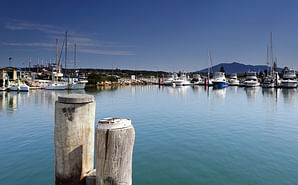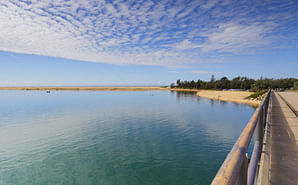Local Environmental Plan amendments
Information on how to prepare a proposal to amend a portion of the Bega Valley Local Environment Plan 2013 (BVLEP 2013).
Guidelines for Local Environmental Plan Amendments
A change to planning zones or controls to permit new development and land uses require an amendment to the Local Environmental Plan (LEP).
Preparing a LEP Amendment - Planning Proposal
The preparation of a planning proposal is the first step in making an amendment to a LEP. A planning proposal is a document that explains the intended effect of, and justification for, a proposed amendment to a Local Environmental Plan.
Requirements of a planning proposal
The NSW Department of Planning and Environment’s Local Environmental Plan Making Guideline (2021) provides guidance on the requirements of a planning proposal.
A planning proposal must have both strategic merit and site-specific merit and be justified.
- Strategic merit:
- How it gives effect to a regional or local planning strategies - including any draft released for public comment (link to regional strategy is here and local strategies here)
- How it is responding to a change in circumstances, such as the investment in new infrastructure or changing demographic trends that have not been recognised by existing planning controls.
- Site-specific merit:
- Having regard to the natural environment (environmental values, resources or hazards)
- Having regard to the existing uses, approved uses and likely future uses of land in the vicinity of the land subject to a proposal
- Having regard to the services and infrastructure that are or will be available to meet the demands arising from the proposal and any proposed financial arrangements for infrastructure provision.
- Justification for a planning proposal:
- A planning proposal must identify how it gives effect to and is consistent with relevant legislation, State Environmental Planning Policies (SEPP) and local planning directions.
Planning proposal timeframes
The process for the preparation and assessment of a planning proposal differs for each proposal according to the complexity. The Department of Planning and Environment have released benchmark timeframes where they are consistent with the state government’s strategic planning framework:
| Category of Planning Proposal | Example of category | Expected Timeframe |
|---|---|---|
| Basic | To correct administrative errors; to list a local heritage | 220 days |
| Standard | To change land use zone; altering principle development standards; additional permitted land uses | 320 days |
| Complex | Changes that would result in a significant increase in demand for supporting local; regional or State infrastructure; respond to a new policy; inconsistent with a Regional Plan or Local strategic planning | 420 days |
Process for preparing a Local Environmental Plan amendment:
The NSW Department of Planning and Environment’s Local Environmental Plan Making Guideline (2021) provides a detailed explanation of the steps of the LEP making process.
Step 1: Pre-Lodgement
The pre-lodgement stage is required to provide early feedback to an applicant about the strategic and site-specific merits of a proposal and the supporting studies required for a proposal. This stage enables an applicant to gain feedback from Council and relevant state government agencies prior to formal lodgement of a planning proposal.
- In first instance, it is recommended to contact Council’s Strategic Planning section to discuss a proposal.
- Prepare a scoping document to support the pre-lodgement phase and relevant studies in accordance with the NSW Department of Planning and Environment Local Environmental Plan Making Guideline (2021). Please find a copy of 'Attachment A’ here and 'Attachment C' here referred to in the guidelines. This is a template for all types of planning proposals to provide guidance on the detail that should be included in a scoping proposal. It is strongly recommended that applicants gain professional assistance to assist with preparation of the scoping document from a town planning consultant.
- Lodge scoping document and relevant studies to Council via email to: council@begavalley.nsw.gov.au
- Pay fee. Council will issue an invoice for payment of fee that applies for the scoping service. The fees are in accordance with Council’s published fees and charges.
- Council officers will then refer the scoping document to relevant Council departments and state government agencies for comment
- Pre-lodgement meeting with Council’s Strategic Planning section and relevant state government agencies where a particular issue has been identified that requires feedback on the proposal
- Council officers complete the initial assessment of the scoping document and provides written advice to the applicant.
Step 2: Planning Proposal
The planning proposal stage is where an applicant prepares and lodges a planning proposal. Council officers review and assess the planning proposal and decide whether to recommend that Councillors support and submit it to the Department of Planning and Environment for a Gateway determination.
Please find a copy of ‘Attachment C’ here that are referred to in the guidelines.
- Prepare a planning proposal and technical studies in accordance with the NSW Department of Planning and Environment Local Environmental Plan Making Guideline (2021) and as specified by Council. It is strongly recommended that applicants gain professional assistance to assist with as the preparation of the planning proposals from a town planning consultant.
- Lodge the planning proposal to Council via the Planning Portal
Pay fee. Council will issue an invoice for payment of fee that applies for the assessment and processing of the planning proposal. The fees are in accordance with Council’s published fees and charges. - Council’s consideration of the planning proposal. The planning proposal must be formally considered at a Council meeting. Council staff will present a report to Council regarding the proposal and will make a recommendation for Council’s consideration whether to support and submit it to the Department of Planning and Environment for a Gateway determination. Council does not have to support a planning proposal.
- A planning proposal under assessment can be viewed on the planning portal.
Step 3: Gateway Determination
The Department of Planning and Environment assesses the strategic and site-specific merit and justification of a planning proposal and issue a Gateway determination specifying if it should proceed and the community consultation requirements.
- If Council agrees to support the planning proposal, Council staff forward the planning proposal to the Minister for Planning and Homes via the planning portal for a Gateway determination.
- The Department of Planning and Environment reviews the proposal against set criteria and make recommendations to the Minister whether or not to proceed. At the Gateway determination, the Minister (or delegate) will decide:
- whether the planning proposal should proceed (with or without variation)
- whether any additional studies are required and if necessary, the scope of these additional studies
- whether the planning proposal should be re-submitted for any reason (including provision of further studies or other information, or for the revision of the planning proposal)
- the community consultation required
- any consultation required with state or commonwealth public authorities
- the time frames for the various stages of the planning proposal.
- A Gateway determination for a planning proposal can be viewed on the planning portal under the section pre-exhibition
Step 4: Post Gateway Determination
In the post Gateway determination stage, Council officers review the determination and ensure any required conditions have been actioned prior to public exhibition. If the Gateway determination requires additional studies or information, the applicant will be required to produce these studies or information in accordance with the directions of the Gateway determination.
Step 5: Public exhibition and assessment
In this stage, Council will consult with the community and refer the proposal to state government or commonwealth public authorities as per the Gateway determination. Public exhibition of a planning proposal can be viewed on Council’s website under the section ‘have you say’ or on the planning portal
During the public exhibition period the community can make a submission concerning the proposal. Council can provide a copy of submissions to the applicant to provide a response, or any additional supporting information required.
All submissions received during the public exhibition period will be considered as part of the assessment process. Council is not bound to adopt or support a submission. Any substantial changes to the planning proposal as a result of submissions will be required to be reported to Council to progress the proposal.
A public hearing may also be arranged, if the issues raised in the submissions are considered by Council to justify a hearing, and a report will be prepared and made public.
Step 6: Finalisation
In the post Gateway determination stage, Council officers review the determination and ensure any required conditions have been actioned prior to public exhibition. If the Gateway determination requires additional studies or information, the applicant will be required to produce these studies or information in accordance with the directions of the Gateway determination.
- If Council agrees to support the planning proposal, Council staff forward it to the Department of Planning and Environment where the LEP amendment is drafted for the Minister’s approval and the legal instrument is formally gazetted.
Disclosure of political donations
A Political Donation and Gift Disclosure is required when a planning proposal is formally lodged on the planning portal. Under s147 of the Environmental Planning & Assessment Act 1979, all relevant political donations and gifts must be disclosed by individuals or entities with a relevant financial interest when a planning application is made.






Was this helpful?